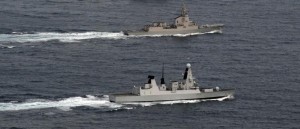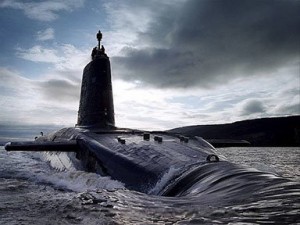
Following Kyle Mizokami’s own shot at war simulation, I apply the exercise to European waters by focusing on a potential clash over Gibraltar.
Much has been written about the so-called frozen conflicts of Eastern Europe but few pay attention to the crystallized conflicts of Western Europe. There are border disputes between Portugal and Spain, Spain and Morocco, France and Italy, Ireland and the UK, Netherlands and Germany, Serbia and many of the post-Yugoslav republics, etc. Perhaps the one that most often elicits media attention is Gibraltar – with rival claims by the UK and Spain unresolved to this day.
Periodically clashes occur between British and Spanish forces in the territorial waters (with 28 Spanish ‘incursions’ in Jan alone) – and more rarely in the land border crossing – of ‘the rock’. This article addresses from a military perspective the potential for conflict as well as the likely outcome of one.
Imminent War?
Is there a threat of imminent war? In short the answer is a resounding ‘no’. Using the Falklands conflict as analogy one can conclude that Gibraltar is not as economically important as the Falklands – with its fishing banks, a large EEZ and potential oil and gas reserves – and Spain is not as politically populist as Argentina – whose politicians are ever-tempted to use the Falklands as a ‘rally to the flag’ instrument in times of economic downturn. Nor is Gibraltar that far from Great-Britain and hence as strategically vulnerable. Then there are the catastrophic diplomatic and political consequences of a conflict between two EU and NATO member-states, and the underlining fact that Madrid is much more militarily on par with London than Buenos Aires could ever hope to be in the foreseeable future – the UK spends around $60 billion ($17 billion goes to the Royal Navy) to Spain’s $14 billion ($2 billion goes to the Armada) in their respective militaries, but both spend far more than Argentina’s meager $3 billion in overall military expenditure.

Strategically the case against belligerence grows even stronger if one considers the relative advantage Spain would enjoy fighting a war in its own turf. The UK would be forced to fight this war – if one assumes the UK would want to fight in the Mediterranean – 2000 km away from its shores (if, of course, one does not include Gibraltar itself). This means the Royal Air Force would be of little or no use, especially considering that neither air force enjoys advantages in aerial warfare – both Spain and Britain deploy the Eurofighter Typhoon as air superiority fighter – and that Britain no longer flies strategic bombers, which might have helped target Spanish installations with cruise missiles. That said, Britain would still have a distinct advantage in numbers with its 5 destroyers, 13 frigates, 11 submarines, and 2 amphibious assault ships. In operational terms, this means London could continuously deploy a task-force comprising 6 surface combatants, 3 submarines and probably 1 assault ship. Madrid operates 5 destroyers, 6 frigates, 3 submarines and 3 assault ships but without the hindrance of force projection, it could probably operate half of them continuously. This means in turn that together with the aid of the Spanish Air Force and with the Armada’s 10+ coastal patrol vessels, it could very possibly keep the Royal Navy away from its continental shores. An important factor would be the gap that the Portuguese coast represents in separating Spain’s Atlantic fleet from its Mediterranean ones: no fighting would be tolerated in Portuguese territorial waters and EEZ which means that while Spain could theoretically move its ships through Portuguese waters, the British would also be able to shadow them, and this would imply a great risk. More dubious would be its defense of the Canary Islands which would be vulnerable to British submarine warfare and thus tactical isolation. The two nations’ maritime concerns throughout the world, from fishing fleets to oil tankers, would be equally vulnerable to interference from occasional minor naval sorties from either fleet – conceivably the British could capture Spanish trawlers in the Atlantic and the Spaniards could intercept British oil tankers out of the Middle East. Spain would be able to prevent the British navy from crossing the strait of Gibraltar and could then deploy the occasional warship to the Red and Arabian seas while Britain could do the same but with much longer lines of supply. The Royal Navy could also force Madrid’s Atlantic fleet into coastal defense, and pick off Spanish civilian vessels one at a time in the Atlantic Rim.
The result of a conventional conflict would thus be a draw, with no side able to win without spilling too much blood and treasury to prove the issue. More likely than all-out war might be a single clash: one bad enough to bring both parties to a halt and later on to the negotiation table.
Single Engagement
Most clashes in the area of Gibraltar occur between Royal Gibraltar Police and the Royal Navy’s Gibraltar Squadron small craft on one side, and on the other small craft of Spain’s Guardia Civil – a paramilitary force which is also used as the Spanish Customs Surveillance Service – and most often, Spanish fishing vessels. None of these is heavily armed and none could go beyond exchanging gunfire.
Among the reported incidents involving the Spanish Armada itself, the biggest vessels to date were the 27 crewed Anaga-class ship Tagomago and the 100+ crewed Descubierta-class corvette Vencedora. The Royal Navy in turn deploys periodically to Gibraltar, with warships transiting through the Mediterranean – generally frigates such as the 180+ crewed Duke-class HMS Argyll – in an attempt to deter the Spaniards from further incursions in what London calls “Gibraltar territorial waters”.
If a major exchange were to happen – be it carefully planned or as a result of hotheads – these would likely be the type of vessels involved. Who then would get the upper hand?
Combat Tactics

For the purpose of this scenario we’ll give only a cursory look at the Tagomago aside and go instead with the corvette Vencedora since the former would have no means of counter-attack due to its lack of heavy armament. A Harpoon-missile attack from the Argyll on Tagomago would actually be overkill since one missile alone suffices to disable a frigate and to use it against a patrol boat would likely disintegrate the craft’s structure. On the other hand, if the Argyll’s crew couldn’t obtain radar lock (the Harpoon needs a minimum firing range of 3km) or decided to switch to the frigate’s 114mm Mark 8 gun, the result would still be disproportionately bad for the Tagomago, which would sustain the hits of heavier shells fired from a longer range and guided by an automatic targeting system; the Spanish ship would not be able to respond in kind with either of its 76 mm Mk22 or Oerlikon Mod. 5 TG 20 mm cannons and it would be facing a much bigger target.
The Vencedora would be a different proposition altogether as the Descubierta class can be deadly to a frigate in close proximity. The good news for the British is that if Argyll fired first, the old corvette would likely not survive the impact, not least because it lacks a CIWS system. On the other hand, what chance would the Vencedora have if it detected Argyll’s radar lock and preempted the missile attack with one of its own? At a great distance Argyll’s air-defense Sea Wolf missiles and two 30mm DS30M Mark 2 Automated Small Caliber Guns should be able to intercept perhaps two incoming missiles, and lets optimistically discount another two lost to the British frigate’s electronic counter-measures. However if the Spanish corvette fired a complete volley of its eight Harpoons the Argyll would surely not live to fight another day. Yet a third possibility would be for Argyll’s helicopter to fire first on the Vencedora. Every Duke-class vessel carries a helicopter, one usually intended for anti-submarine warfare, and HMS Argyll carries a Westland Lynx which can also be equipped with anti-ship missiles. If the British wanted to sink the corvette, it might be preferable to risk a helicopter rather than a frigate. If the British intended only to intimidate, the helicopter could also be a good option since it would send a message without exposing the lives of 180+ British sailors to a Spanish overreaction, even if the helicopter itself would become an easy target for the corvette’s Sea Sparrow air defense system.
A second possible type of engagement is the less dire possibility of the two ships exchanging cannon fire. This would have the potential of avoiding de facto war by allowing both ships to attempt intimidation, save face, and avoid the complete destruction of ships and the death of hundreds. Such an exchange would pit the Argyll’s 114 mm Mark 8 against the Vencedora’s Otobreda 76 mm. The two guns have similar range and both fire High-Explosive shells; the difference is in the number of projectiles fired per minute which is higher in the 76mm and the size of the projectile which is bigger in the 114mm. Another essential factor would be the top speed of each vessel which would give a competitive edge in maneuvering to the fastest ship, in this case the British frigate. Because the British frigate would pack more of a punch and would be able to position itself better, the outcome of this encounter also leaves the British on top.
In addition, given the Spaniards task is essentially to provoke with their presence so as to deny acceptance of Britain’s local sovereignty fait accompli – it stands to reason that the British vessel would be the first one to fire. The tactical advantage of initiative together with the British frigate’s superior weaponry would most likely punish the Spaniards for their trespass, even if at close distance the Spaniards would enjoy some equalizing edge.
Of course as previously mentioned the victory would be tactical rather than strategic. Trading blows would be a media sensation and the electorates would almost certainly push for a real push for a permanent political settlement.
Miguel Silva is a Portuguese international relations analyst and regularly writes for the publications Eurasia Review, Small Wars Journal and the Atlantic Sentinel

